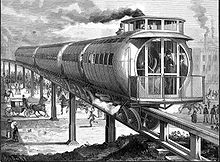Meigs Elevated Railway
Meigs Elevated Railway was an experimental steam-powered monorail in Cambridge, Massachusetts , invented by Joe V. Meigs .
technology
The weight of coating was from one track with the track width 559 mm (22 inches worn). The train was balanced by a set of horizontal wheels mounted 1067 mm (42 inches) above the mounting rails.
history
Joe Meigs built his 70 m (227 feet ) long elevated railway on Bridge Street (now Monsignor O'Brien Highway) in East Cambridge in 1886 to demonstrate the benefits and possibilities of a monorail. It was never extended and ran until 1894. A fire probably caused by arson destroyed the depot as well as the experimental train and tender and damaged the locomotive.
Individual evidence
- ^ The Meigs Elevated Railway . Scientific American. July 10, 1886.
- ↑ a b Robert Campbell and Peter Vanderwarker; "Meigs Elevated Railway". ( Memento of the original from January 1, 2005 in the Internet Archive ) Info: The archive link was inserted automatically and has not yet been checked. Please check the original and archive link according to the instructions and then remove this notice. Boston Globe, February 23, 1992.
- ^ Joe V. Meigs, "The Meigs Elevated Railway System: The Reasons For Its Departures From The Ordinary System," 1887 (Boston: Charles H. Whiting).
- ^ Passenger Car Destroyed Meigs Elevated Railway. An Incendiary's Work at the Shop of the Meigs Car Company - The Superb Passenger Car Greatly Damaged. Daily Evening, February 4, 1887.
Coordinates: 42 ° 22 ′ 4.8 ″ N , 71 ° 4 ′ 14.9 ″ W.
